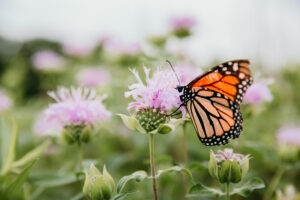
Kelli Kennon-Lane. (Photo by Liz Zabel)
The Gazette is working with the Linn Landowner Forum to present a weekly series of columns about elements landowners should consider when replacing trees and plants lost in the Aug. 10 derecho. The series will focus on recovery, the importance of native plants and other topics. Fourth in a series.
Many property owners in Linn County are seeing the light — literally.
With trees and shrubs downed or damaged, properties are looking a lot sunnier these days. The now-ample sunlight proved an unforeseen benefit to the Aug. 10 derecho: the opportunity for property owners to transform their yards — possibly now a blank canvas — into a bird- and pollinator-friendly habitat. Or, at the very least, into a functional space that allows the household to live more lightly on the earth.
Before jumping in to transform your green space, we advise starting with a plan. This will save you time, money and energy in the end.
Commit to a spring planting and make your plan this fall or winter. Map out the green space in your yard. Know the amount of space available to work with and set a budget. Put key dates on the calendar (like local plant sales, predicted last frost date, ideal planting times). Research keystone species of trees and shrubs — that is, trees and shrubs that historically have grown and thrived in our area for centuries rather than those introduced in recent years. Keystone species are more likely to provide the habitat that pollinators and birds in our area need to thrive. Learn more about keystone plants at the center’s website, indiancreeknaturecenter.org.
Add a variety of bird feeders. Local farm stores carry an impressive variety of bird seed in bulk, which eliminates the need for plastic bags. Bring an empty container from home, have it weighed at the cash register (this is called the tare weight), fill it with one variety of bird seed, write down the corresponding PLU number and have the full container weighed at checkout, subtracting the tare weight of just the container.
For those looking for an educational opportunity for the whole family, consider making a tray bird feeder or bird house. Turn that tree stump in the backyard into a bird bath. Creating a bird or pollinator habitat not only adds functionality, but also beauty.
Spring is the perfect time to plant wildflowers, prairie plants, berry bushes and other shrubs to create an ideal pollinator habitat. Lucky for you, the Indian Creek Nature Center’s Plant and Art Sale on the first Saturday in May features dozens of varieties of these plants, both perennial and annual, at an affordable price.

Monarch on Monarda, a native Iowa plant that early settlers used to make tea. Blooming in July and August, Monarda is also called Bee Balm, Bergamont and Horsemint. (photo by Liz Zabel)
Also available at the plant sale will be vegetable seedlings. While vegetable gardens aren’t the best habitat for pollinators, they are ideally suited for sunny backyards and don’t only feed yourself and your family, but also significantly lower your carbon footprint by reducing the overall amount of fossil fuels used to transport food to your dinner table.
For first-time vegetable gardeners, a raised bed with nutrient-rich soil is essential to a productive garden. Spend the winter months reading books and blogs written for our plant hardiness zone, which is 5a, and order a Seed Savers Exchange catalog (seedsavers.org). Research topics like succession planting and companion gardening to maximize production in a smaller space.
Lastly, if you’re not already taking advantage of the city of Cedar Rapids’ progressive curbside compost program, consider starting now. Kitchen and yard waste can be composted easily in your Yardy or in a small space in the backyard. If done correctly, there should be little to no odor or pests.
Nutrient-rich compost provides fertilizer with no chemicals (perfect for your new garden) and avoids adding to unnecessary waste to the landfill.
We hope Linn County homeowners take advantage of these tips, and continue to look on the sunny side of the derecho. While this storm has no doubt been devastating — not only to us, but to the wildlife that resides in our shared habitats — the destruction also has ecological benefits that will help our natural environment grow back stronger than before.
Nature is resilient, and so are we.
Kelli Kennon-Lane is the director of education at Indian Creek Nature Center, where she oversees programming and educational initiatives related to the center’s mission to create champions of nature. She was raised in raised in northeast Iowa and has lived in Linn County for the last 15 years.

